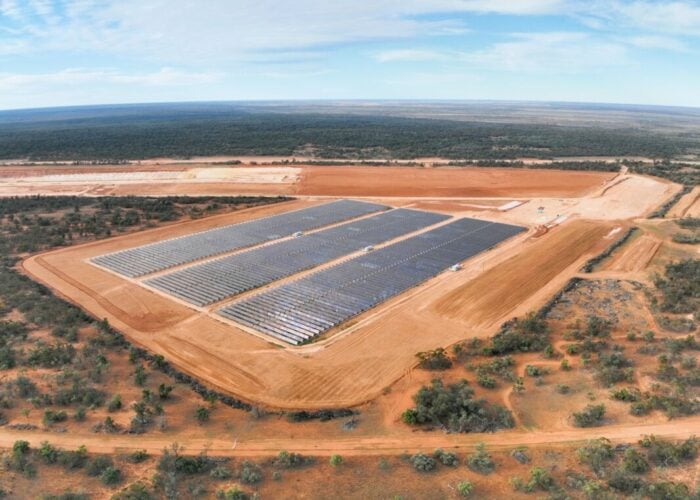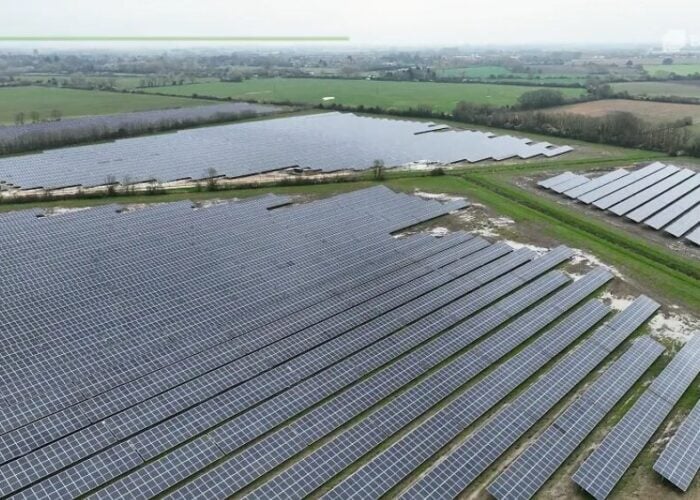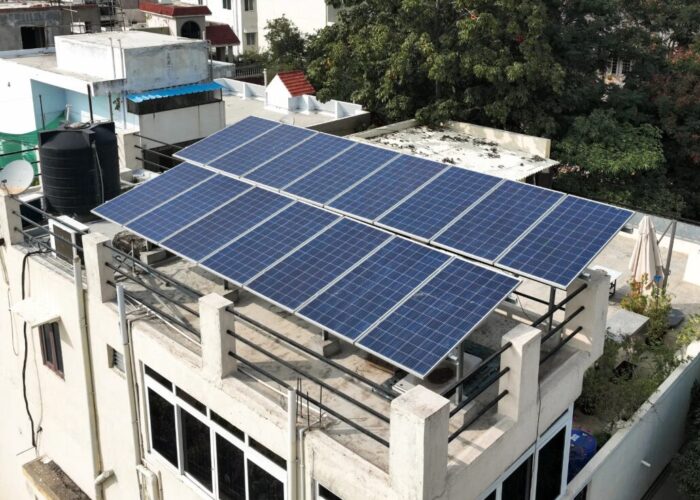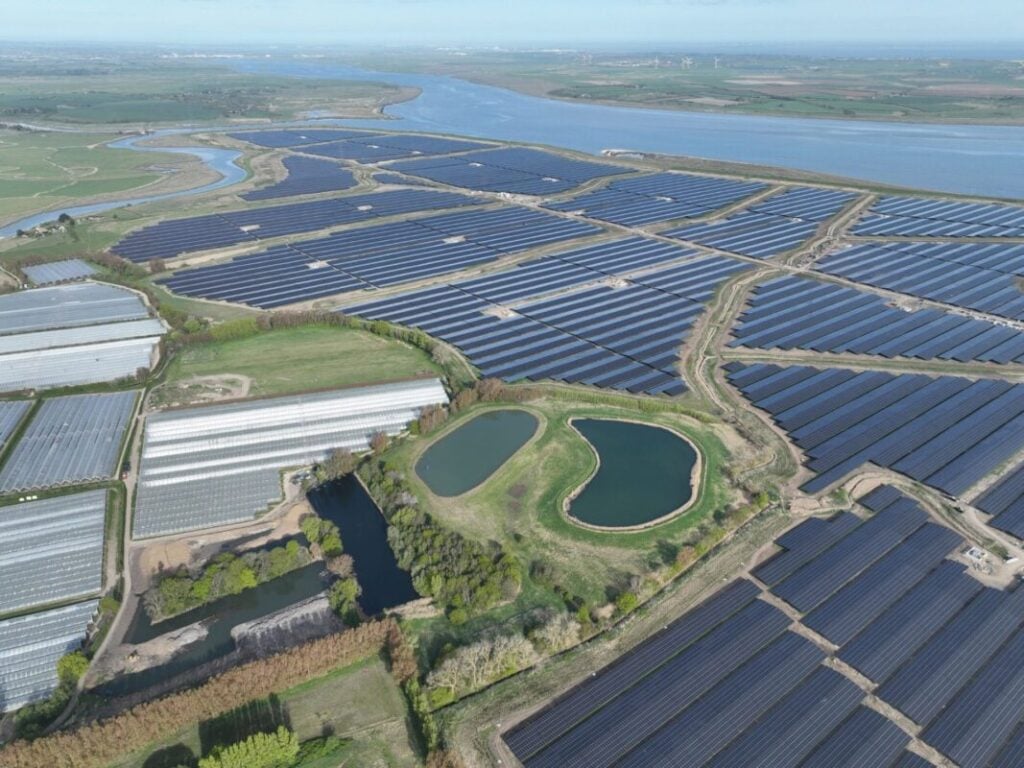
The UK government and solar industry have jointly published a long-anticipated roadmap detailing how to maximise the country’s solar potential. Chris Hewett, CEO of Solar Energy UK, takes a closer look at the details.
Try Premium for just $1
- Full premium access for the first month at only $1
- Converts to an annual rate after 30 days unless cancelled
- Cancel anytime during the trial period
Premium Benefits
- Expert industry analysis and interviews
- Digital access to PV Tech Power journal
- Exclusive event discounts
Or get the full Premium subscription right away
Or continue reading this article for free
A new era of clean energy independence dawned in early July, with the publication of the UK’s highly anticipated Solar Roadmap [1].
The government-industry paper describes 62 practical measures to boost the supply of cheaper and more secure power, deliver new industries and create skilled jobs – all while providing significant reductions in greenhouse gas emissions and gains in biodiversity. By addressing issues such as the electricity grid, supply chain, skills and planning, it will play a major role in delivering the British Labour government’s mission for the UK to become a clean energy superpower and meet – or potentially exceed – the capacity goals set out in December’s Clean Power 2030 Action Plan.
By then, we could see around 9 million small-scale rooftop installations, up from 2 million now, with the sector supporting 35,000 jobs – almost twice the number of today. Meanwhile, solar farms would still take up a tiny amount of the country, put at significantly less than 1% of farmland.
The roadmap was produced over two years and two governments by the Solar Taskforce, led by secretary of state for energy security and net zero, Ed Miliband, and Solar Energy UK, and supported by leading figures from across the solar industry and related sectors. The taskforce will shortly transition into the Solar Council, set to drive future progress and guide the implementation of the plan.
Writing in a foreword to the roadmap, the secretary of state wrote: “This is an incredibly exciting time for solar in our country. More than 1.5 million homes across Britain now have solar installed, and since this government came to office my department has consented almost 3GW of nationally significant solar projects – nearly three times as much as the previous 14 years combined. But we know we need to go further to deliver our goals for clean power by 2030 and beyond
“Solar offers huge potential to boost our energy independence, bring down bills and tackle the climate crisis. It also presents significant economic opportunities; we estimate that around 35,000 jobs supported by solar will be needed by 2030, a doubling of today’s number.”
Added to those reflections, solar energy is among the lowest-cost and most popular forms of power generation in the UK. Unlocking its potential will increase Britain’s energy security, drive down bills and be a major contributor to preventing dangerous climate change. The fact that it can be deployed rapidly in so many ways, from household rooftops to warehouses to reservoirs and large-scale solar farms, is the key ingredient to this potential.
Rooftop
Despite enormous cost reductions over recent years, one key barrier to more widespread adoption of rooftop photovoltaics remains their upfront cost. So, the government will work with the Green Finance Institute, the finance sector, consumer bodies and the solar sector itself to provide financial solutions for all customers.
The taskforce also identified an ongoing lack of awareness of the benefits of both domestic and commercial solar energy as a further obstacle, with potential buyers unaware of trusted sources of information. Accordingly, the government will update its Energy Efficient Home website to promote solar deployment. Meanwhile, the UK Warehousing Association has agreed to develop a toolkit for the commercial-scale market, including how to obtain a power purchase agreement.
How solar is reflected in energy performance certificates will be updated next year, and incentives to install solar energy will be considered for social landlords. Meanwhile, the Royal Institution of Chartered Surveyors will ensure that the value of solar homes is assessed properly, while incentives to install solar power on social housing will be considered.
As may be expected, the paper also mentions the recently confirmed Future Homes Standard. This should, alongside the forthcoming Future Buildings Standard, virtually mandate solar on new properties. In due course, retrofit customers will benefit from a review of consumer protections, so they can have confidence in the quality of work when upgrading their homes.
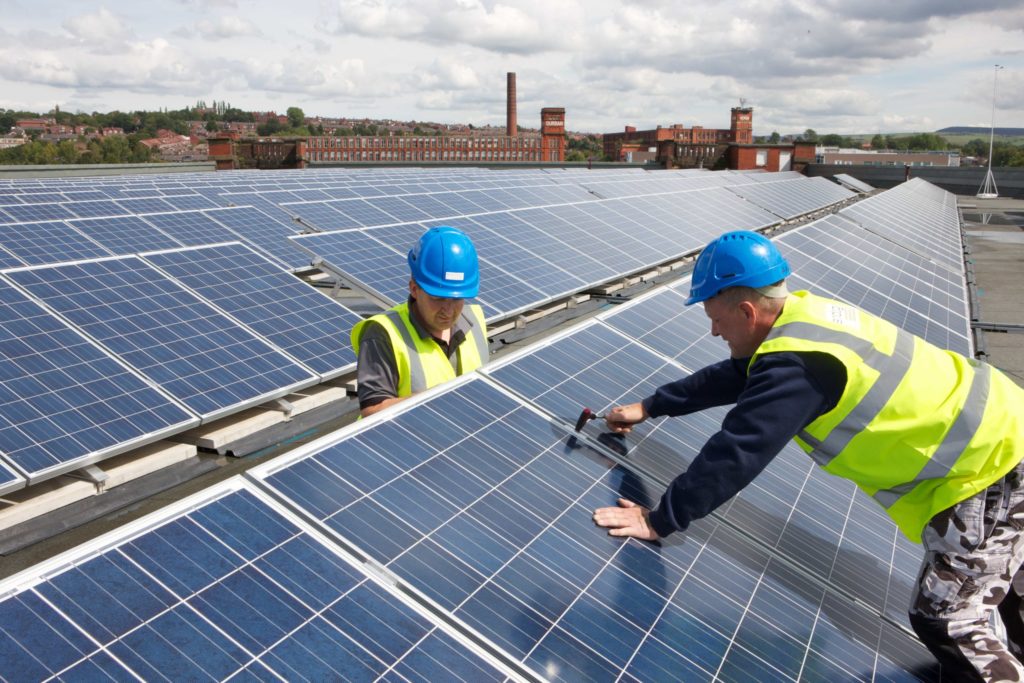
Warehousing has huge potential to expand solar generation but faces many barriers [2]. To resolve these, the UK Warehousing Association will collaborate with the real estate and solar sectors to overcome problems with building leases, develop standard contracts for landlords and tenants and develop a standard approach for building valuation. The connection processes of independent distribution network operators (DNOs), which often operate power systems in business parks, will be reviewed and the regulation of the sector reconsidered by the regulator, Ofgem.
According to government estimates, only around one in five schools have solar panels, leaving them paying for power rather than investing in the nation’s youth. To help remedy this, the government will commit to supporting schools to deploy the technology, possibly through the DESNZ’s ‘one stop shop’ Net Zero Accelerator Service, building on the newly founded, publicly funded clean energy company GB Energy’s recent investment in 200 schools, in which it plans to spend £180 million on investing in 70-100MW of PV on schools and hospitals.
Supporting its anticipated Local Power Plan, GB Energy will provide “funding, capacity and capability support at all stages of project development”, to drive the growth of community energy, building on the Local Net Zero Hubs Programme. In parallel, the National Wealth Fund also offers free advice and low-cost, long-term finance to local authority infrastructure projects that align with net-zero and economic growth mandates, which includes the development of solar projects.
Meanwhile, the National Wealth Fund will “explore potential structures to finance solar projects or portfolios”. The Department of Business and Trade will coordinate a cross-government steering group to “consider potential government intervention” to promote corporate power purchase agreements – buying power directly from solar farms, at a significant discount from the grid.
A study into the safety of small-scale solar energy systems that can be plugged directly into the domestic mains supply will also commence. Current UK regulations forbid them, although they are increasingly popular on the Continent.
Grid access
Excessive waiting times for electricity grid connections have long been the bane of the solar industry, for both ground-mounted and large-scale rooftop systems.
The Solar Roadmap spells out a series of measures to address the issue, in parallel with reforms arising from the Winser Review and raising transmission impact assessment thresholds. These include adopting a common definition of commercially sensitive data, which should provide a better understanding of which projects are most likely to proceed. Ofgem will also consider introducing standards to improve levels of service after grid connections are accepted, with the UK’s National Energy System Operator (NESO) conducting a series of technical measures to improve transmission impact assessments.
As things stand, solar projects above 3.68kW, corresponding to 16 amps per phase, must receive approval from DNOs. This red tape can encourage installers to limit system capacity below the threshold, though one operator has raised the threshold to 5kW, encouraging larger residential installations. Those under 14.72kW are now subject to a fast-track process, with responses due within ten working days.
The roadmap also indicates that high-voltage overhead power lines over 2km long mounted on wooden poles will no longer be considered nationally significant infrastructure projects due to their low visual impact.
One of the most welcome aspects of the package concerns the treatment of battery energy storage systems (BESS), commonly co-located with solar farms. BESS are currently considered a hindrance to the electricity system, rather than providing the benefits of absorbing excess power and supplying it during periods of peak demand. New and harmonised modelling procedures will be introduced in response.
Reforming who pays for new high-voltage supergrid transformers, which the roadmap describes as a “postcode lottery”, is also expected.
Ground-mount solar
The roadmap endorses Solar Energy UK’s Community Engagement Good Practice Guidance [3]. Aside from supporting developers, operators and the supply chain, it is equally “useful to local authorities and communities as a referencing material for engaging with solar industry developers and operators”, says the paper.
The association has also committed to developing a template for developers to use for stakeholder mapping and a communications toolkit for conveying the benefits of solar power when engaging with local communities.
In parallel, the provision of community benefits has a vital role to play, and it is the subject of an ongoing DESNZ consultation [4]. While the Government’s position is being considered, Solar Energy UK will publish a voluntary protocol and guidance for community benefits later this year, covering installations over 5MW (other than rooftop, ‘behind the meter’, community-owned or community-led solar farms).
Scotland is consulting on refreshing its principles for community benefits, while the Welsh Government has already issued guidance [5, 6].
Supply chain
The roadmap represents a “once-in-a-generation opportunity to grow the solar supply chain and manufacturing capacity in the UK”. While economics exclude the manufacturing of conventional silicon-based panels, there is scope to grow the production of transformers, inverters, switchgear, supporting bracketry and cabling, it says, not to mention batteries and R&D, particularly for lightweight and cutting-edge perovskite PV technology.
Accordingly, the government will consider supporting companies looking to scale up production of innovative solar technologies, processes and associated equipment, alongside the development of standards and testing facilities for next-generation solar technologies.
The roadmap also details the government’s support for the “world-leading” Solar Stewardship Initiative, intended to prevent the procurement of solar panels produced with raw materials coming from forced labour. This comes after confirming that the system will be used by Great British Energy.
“The UK Government is clear that there should be no procurement of solar panels where there is evidence of forced labour. Government will empower contracting authorities to exclude suppliers from government contracts who have committed labour market misconduct and/or environmental offences in the UK or overseas… The UK solar sector has been proactive in its response to this issue,” says the roadmap, noting Solar Energy UK’s Supply Chain Statement and Responsible Sourcing FAQ [7, 8].
Skills development
The rapid growth of the UK solar industry, expected to expand by up to 17% this year, “offers a generational opportunity to create a wealth of high-quality jobs. At this crucial juncture, we must put the structures in place to build the skilled workforce needed now and in the decades to come,” the roadmap says.
Without action, there is a risk of skilled labour shortages, skills gaps, loss of key skills “and potentially costly, urgent intervention further into the future,” it warns.
Solving the problem will require intervention from across government, including the National Wealth Fund, GB Energy, Skills England, the Office for Clean Energy Jobs and the devolved administrations. Solar Energy UK has also stepped up, with the formation of the Solar Careers UK initiative, which will provide information and guidance on what skills and competences are needed for jobs in the sector and how to attain them. It has already held its first careers fair and is continuing to expand engagement.
The roadmap itself offers no fewer than 11 actions on skills, including improving the provision and effectiveness of training, mapping the routes to competence for core occupations and connecting colleges and businesses. Solar Energy UK will work with other trade bodies on how to attract and retain newly trained installers and prepare teaching materials for schools.
Planning
In the case of development planning, much of the action needed to help the sector has already been undertaken or is underway. This includes raising the threshold for solar farms to be considered ‘nationally significant infrastructure projects’ from 50MW to 100MW, in force from the end of the year, and the recruitment and training of new planning officers.
The Planning and Infrastructure Bill currently proceeding through parliament will simplify the consenting process for major infrastructure projects and require national policy statements to be reviewed every five years. The environmental impact assessment system is also being streamlined, and the first Spatial Energy Plan and Land Use Framework are being developed.
The National Planning Policy Framework has been reformed to give greater weight to the benefits of renewable energy and proposals’ contributions to meeting net zero, and a consultation on the National Policy Statement for Renewable Energy was held recently [9].
But there is still more to do. Solar Energy UK has committed to working with the planning profession to ensure that training is fit for purpose. It will also produce factsheets to advise planners and councillors, plugging the gap in the expertise needed to assess solar applications effectively. We also intend to engage with any regional mayor or combined authority interested in driving forward solar developments in their area.
There is also work to do in relation to floating solar, which has significant potential but currently faces higher costs than deployment on the ground. Reforms to support the nascent sector will be considered under the planning regime and potentially via the Contracts for Difference system.
Solar Energy UK would like to extend our sincere thanks for the work of the former co-chairs of the taskforce, Andrew Bowie MP and Graham Stuart MP, alongside the members of its five sub-groups on networks, skills, supply chain and innovation, rooftop solar and communications. We are also grateful to former MP Chris Skidmore, who suggested the taskforce’s formation in his 2023 Review of Net Zero.
References
[1] ‘Solar roadmap: United Kingdom powered by solar’, https://www.gov.uk/government/publications/solar-roadmap
[2] ‘Investment case for rooftop solar power in warehousing’, UKWA, https://www.ukwa.org.uk/wp-content/uploads/2022/09/Investment-Case-for-Rootop-Solar-Power-in-Warehousing-August-2022.pdf
[3] Solar Energy UK, ‘Community Engagement Good Practice Guidance’, https://solarenergyuk.org/wp-content/uploads/2024/07/CGPG2024.pdf
[4] ‘Community benefits and shared ownership for low carbon energy infrastructure: working paper’, https://www.gov.uk/government/publications/community-benefits-and-shared-ownership-for-low-carbon-energy-infrastructure
[5] Scottish Government’s community benefits consultation, https://www.gov.scot/news/community-benefitsconsultation
[6] ‘Local and shared ownership of energy projects in Wales’, https://www.gov.wales/sites/default/files/publications/2022-06/guidance-local-and-shared-ownership-of-energy-projects-in-wales_0.pdf
[7] Solar Energy UK, ‘Solar supply chains: sustainability issues and action’, https://solarenergyuk.org/resource/solarsupply-chains-sustainability-issues-and-action/
[8] Solar Energy UK, ‘Responsible Sourcing Guidance’, https://solarenergyuk.org/resource/responsible-sourcingguidance/
[9] ‘Planning for new energy infrastructure: 2025 revisions to National Policy Statements’, https://www.gov.uk/government/consultations/planning-for-new-energy-infrastructure-2025-revisions-to-national-policy-statements
Author
Chris Hewett became the chief executive of industry body Solar Energy UK in 2018, bringing 25 years of experience in environmental and energy issues. He was previously head of climate change for the Environment Agency, an associate at Green Alliance and a senior research fellow at the Institute for Public Policy Research. He was co-chair of the government-industry Solar Taskforce that produced the roadmap.




